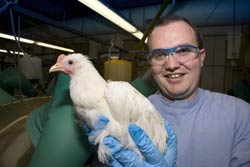To date, Poultry CRC research has resulted in four patents, each of which may enhance or radically change Australia’s and, potentially, the world’s poultry industries.
The four patents, Modulating production traits in avians, Antimicrobial peptides, Novel avian cytokines, and Novel toxin, are currently entering, or close to entering, the Patent Cooperation Treaty phase of their prosecution.
“Some of our most exciting technology is protected in these four provisional patents,” explained the CRC’s Commercial Manager, Lloyd Thomson.
Modulating production traits in avians is a gene-silencing technique that allows scientists to switch on or off certain genes to modify the development of the bird.
“For instance, we should be able to have all broiler birds hatched as males, rather than as males and females, ensuring greater uniformity and closer control of the feed conversion ratio across flocks,” explained Lloyd.
“Alternatively, we might be able to have all layers hatched as females, removing the need to cull male birds, which is a clear welfare benefit. If this technology works, it will revolutionise the industry. Simple as that.”
Antimicrobial peptides uses phage-display peptides, which are naturally occurring molecules to bind to the surface of bacteria and either disrupt their functioning or kill them. According to the CRC’s researchers, the beauty of the system is that the molecules precisely target only the bacteria you wish to attack.
The target selected by the CRC is Campylobacter jejuni, a cause of food poisoning arising from improperly cooked meat and unhygienic food preparation.
“While Campylobacter jejuni is not a problem for chickens, it is a significant health concern for humans and one that we would all like to see controlled,” said Lloyd.
Novel avian cytokines covers newly discovered components of the bird’s natural immune system. These cytokines may be employed to enhance the immune system of the bird to assist it to fight off infections or as part of a vaccine adjuvant (carrier) to boost the effectiveness of the vaccine. This patent promises to improve incrementally existing technologies and may extend the life of some vaccines against the constantly changing bacteria and viruses in the environment.
Novel toxin refers to NetB, a toxin recently unearthed by a Poultry CRC PhD scholar, Anthony Keyburn. In finding the new toxin, Anthony refuted almost 30 years of scientific dogma that alpha toxin caused necrotic enteritis (NE) when released into the gut by the bacterium Clostridium perfringens.
NE is a devastating intestinal disease of chickens that results in sickness and, often, death. Having proven that alpha toxin could not be the causative agent and that NetB must play a significant role, the research team are now developing the world’s first effective vaccine for NE.
“This is terribly important work because necrotic enteritis is a disease that costs the planet’s poultry producers an estimated US$2 billion each year,” said Lloyd.
“You can see why we have gone to the trouble and expense to patent these new technologies. We firmly believe that working these patents will bring great benefits to the Australian poultry industry, both directly through application in Australia, and through licensing to overseas poultry health companies.”


